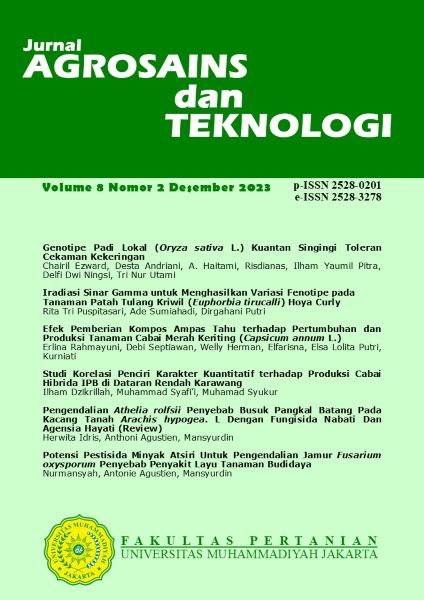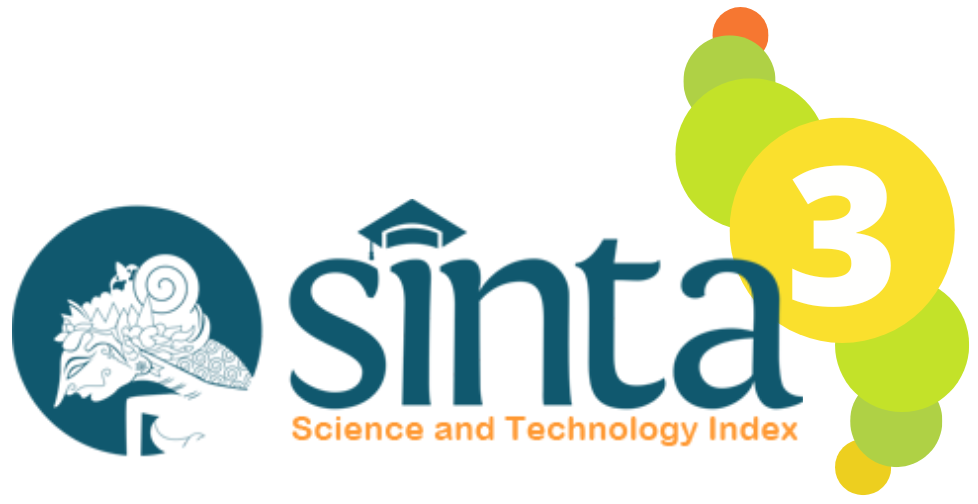Genotipe Padi Lokal (Oryza sativa L.) Kuantan Singingi Toleran Cekaman Kekeringan
DOI:
https://doi.org/10.24853/jat.8.2.54-60Keywords:
Buku, Irri, resisten, ronda putiah.Abstract
Kekeringan memiliki dampak luas terhadap pertanian, seperti penurunan produktivitas dan produksi. Upaya mengatasi permasalahan ini salah satunya yaitu dengan menggunakan bahan tanam (benih) genotipe padi lokal. Genotipe padi lokal telah beradaptasi dengan lingkungan setempat yang spesifik, sehingga memiliki kemampuan beradaptasi pada kondisi cekaman kekeringan. Penelitian ini bertujuan untuk mengetahui genotipe yang toleran terhadap cekaman kekeringan, dengan menggunakan metode eksperimen yaitu dengan sengaja memberikan perlakuan kekeringan pada pot wadah penelitian pada fase pertumbuhan (vegetatif). Cekaman kekeringan diberikan mulai umur tanaman 57 hst sampai 73 hst (selama 16 hari). Selama kondisi cekaman kekeringan muncul gejala daun menggulung dan daun mengering. Hal ini menjadi acuan dalam menentukan tanaman toleran dan peka. Pengamatan fase pertumbuhan tanaman dilakukan pada 4 genotipe padi lokal asal Kabupaten Kuantan Singingi (A = Sironda Putih, B = Saronda Merah, C = Pandan Wangi dan D = Ronda Putiah) ditambah 1 varietas kontrol toleran kekeringan (Inpago 9). Pengamatan dilakukan secara visual pada morfologi daun berdasarkan buku IRRI edisi tahun 1996. Hasil penelitian diperoleh genotipe yang memiliki kriteria toleran cekaman kekeringan yaitu genotipe Sironda Putih, kriteria agak toleran genotipe Saronda Merah, kriteria agak peka yaitu genotipe Pandan Wangi dan kriteria sangat peka genotipe Ronda Putiah. Genotipe Ronda Putiah dapat digunakan sebagai bahan budidaya pada lahan sawah tadah hujan.ABSTRACTDrought has a broad impact on agriculture, such as reducing productivity and production. One way to overcome this problem is by using planting material (seed) of local rice genotypes. Local rice genotypes have adapted to specific local environments, so they have the ability to adapt to drought stress conditions. This research aims to determine genotypes that are tolerant to drought stress, using an experimental method, namely deliberately providing drought treatment to research pots in the growth (vegetative) phase. Drought stress is given from 57 days after planting to 73 days after planting (for 16 days). During drought stress conditions, symptoms of leaf curling and drying of the leaves appear. This becomes a reference in determining tolerant and sensitive plants. Plant growth phase observations were carried out on 4 local rice genotypes from Kuantan Singingi Regency (A = Sironda Putih, B = Saronda Merah, C = Pandan Wangi and D = Ronda Putiah) plus 1 drought tolerant control variety (Inpago 9). Observations were made visually on leaf morphology based on the 1996 edition of the IRRI book. The results of the research obtained genotypes that had drought stress tolerance criteria, namely the White Sironda genotype, moderately tolerant criteria for the Red Saronda genotype, slightly sensitive criteria for the Pandan Wangi genotype and very sensitive criteria for the Ronda Putiah genotype. . The Ronda Putiah genotype can be used as cultivation material in rainfed rice fields.References
Abdullah, A. A., M. H. Ammar, and A. T. Badawi. 2010. Screening rice genotypes for drought resistance in Egypt. Journal of Plant Breeding and Crop Science. 2 (7) : 205-215.
Afrianingsih, S., U. Susanto dan N.R. Ardiarini. 2018. Toleransi Genotipe Padi (Oryza sativa L.) pada Fase Vegetatif dan Fase Generatif Terhadap Cekaman Kekeringan. Jurnal Produksi Tanaman. 6 (3) : 355-363.
Ai.N.S, Tondai. S.M dan Butarbutar. R. 2010. Evaluasi Indikator Toleransi Cekaman Kekeringan pada Fase Perkecambahan Padi (Oryza sativa L.). Jurnal Biologi. 14 (1) : 50 – 54.
Fang, Y., L. Xiong. 2015. General mechanism of drought response and their application in drought resistance improvement in plants. Cell. Mol. Life Sci. 72 : 673- 689.
Imaningsih, W. 2006. Studi banding sifat ketahanan struktural terhadap kekeringan antara varietas padi sawah dan padi gogo berdasarkan struktur anatomi daun. Bioscientiae. 3 (1) : 47-58.
IRRI. 1996. Standar Evaluation System for Rice (SES). Los Banos : International Rice Research Institute.
Liu, H.Y., J.Y. Li, Y. Zhao, and K.K. Huang. 2007. Influence of drought stress on gas exchange and water use efficiency of salix psammophila growing in five places. Arid. Zone. Res. 24 : 815-820.
Martinez, J. P., H. Silva, J. F. Ledent, and M. Pinto. 2007. Effect of drought stress on the osmotic adjustment, cell wall elasticity and cell volume of six cultivars of common beans (Phaseolus vulgaris L.). Europ J. Agronomy 26 : 30-38.
Nazirah, Laila. 2018. Teknologi Budidaya Padi Toleran Kekeringan. CV. Sefa Bumi Persada. Aceh
Salisbury, F.B dan C.W Ross. 1995. Fisiologi Tumbuhan Jilid 1. ITB. Bandung. 241 hlm
Susiyanti, Sulastri. I, Zahratul. M, Widi. A. 2022. Uji ketahanan enam varietas padi (oryza sativa l.) Terhadap kekeringan secara morfologi dan molekuler. Jurnal Agroekotek. 14 (1): 123 – 122.
Suwarno. P.M., Desta, W dan Ahmad, J. 2016. Kendali Genetik Toleransi Kekeringan. Jurnal Agronomi Indonesia. 44 (2) : 119 – 125.
Tubur H.W., M.A. Chozin, E. Santosa, dan A. Junaedi. 2012. Respon agronomi varietas padi terhadap periode kekeringan pada sistem sawah. Jurnal Agronomi Indonesia. 40(3) : 167-173.
Wang, Z., D.J. Mackilland, J.M Bonman. 1995. Partial Resistanceto Blastin Indica Rice. Crop Science. 29 : 848-853.
Wiraatmaja, I. 2017. Bahan Ajar : Cara Tanaman Beradaptasi Terhadap Cekaman Fisiologis. Program Studi Agroekoteknologi. Fakultas Pertanian. Universitas Udayana. Bali.
Xiong, L., R. G. Wang, G. Mao, and J. M. Koczan. 2006. Identification of drought tolerance determinant by genetic analysis of root response to drought stress and abscisic acid. Plant Physiol. 142 : 1065-1074.











